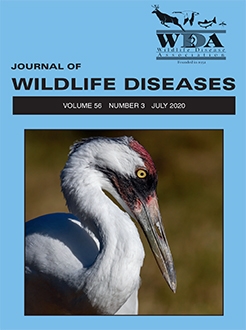We evaluated the health of 31 (eight males, 23 females) founder eastern quolls (Dasyurus viverrinus), translocated to a fenced reserve in the Australian Capital Territory between February 2016 and July 2017. Quolls were wild caught in Tasmania (16 animals) or captive bred at Mount Rothwell Biodiversity Interpretation Centre, Victoria (15 animals). Quolls were assessed for the presence of selected potential pathogens (Toxoplasma gondii, herpesviruses, Salmonella serovars, hemoprotozoa, and ectoparasites). We assessed the relationships among sex, provenance (captive or free ranging), T. gondii or herpesvirus infection, weight, and hematologic and biochemical variables. Six of 21 quolls (29%) tested were seropositive for antibodies to T. gondii. Seropositive quolls weighed significantly more and had significantly lower potassium levels, anion gaps, and urea and triglyceride levels than seronegative quolls had. Eighteen of 31 (58%) combined conjunctival-pharyngeal-cloacal swabs collected from quolls were PCR positive for a newly identified gammaherpesvirus, tentatively named dasyurid gammaherpesvirus 3. There were no significant differences among hematologic and biochemical variables or body weights from PCR-positive and PCR-negative quolls. Eighteen of 18 (100%) of rectal-swab samples were culture negative for Salmonella serovars. Three species of tick (Ixodes tasmani, Ixodes fecialis, and Ixodes holocyclus), two species of mite (Andreacus radfordi, one unidentified), and four species of flea (Pygiopsylla hoplia, Acanthopsylla rothschildi rothschildi, Uropsylla tasmanica, and Stephanocircus dasyuri), were detected on wild-caught quolls, whereas a fifth species of flea, Echidnophaga myremecobii, was detected only on captive-bred quolls. Five of 15 blood samples (33%) were positive for hemoprotozoan DNA via PCR, a novel Hepatozoon species, a novel Theileria species, Theileria paparinii, and Trypanosoma copemani were detected. Despite the presence of several potential pathogens known to be associated with disease in other marsupials, the quolls were considered to be in good general health, suitable for translocation, and a viable population was subsequently established.
How to translate text using browser tools
2 July 2020
BASELINE HEALTH AND DISEASE ASSESSMENT OF FOUNDER EASTERN QUOLLS (DASYURUS VIVERRINUS) DURING A CONSERVATION TRANSLOCATION TO MAINLAND AUSTRALIA
Timothy J. Portas,
Maldwyn J. Evans,
David Spratt,
Paola K. Vaz,
Joanne M. Devlin,
Amanda Duarte Barbosa,
Belinda A. Wilson,
Annette Rypalski,
Claire Wimpenny,
Don Fletcher,
Iain J. Gordon,
Jenny Newport,
Adrian D. Manning
ACCESS THE FULL ARTICLE

Journal of Wildlife Diseases
Vol. 56 • No. 3
July 2020
Vol. 56 • No. 3
July 2020
Dasyurus viverrinus
eastern quoll
ectoparasite
health
Hemoprotozoa
herpesvirus
Toxoplasma gondii




